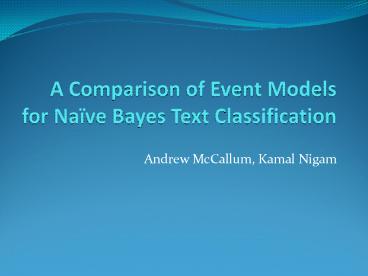A Comparison of Event Models for Nave Bayes Text Classification - PowerPoint PPT Presentation
1 / 18
Title:
A Comparison of Event Models for Nave Bayes Text Classification
Description:
Using the estimates, it classifies new test documents ... Results can vary based on sampling error due to different training and test sets. ... – PowerPoint PPT presentation
Number of Views:67
Avg rating:3.0/5.0
Title: A Comparison of Event Models for Nave Bayes Text Classification
1
A Comparison of Event Models for Naïve Bayes Text
Classification
- Andrew McCallum, Kamal Nigam
2
Motivation
- Text classification approaches using 2 different
first-order probabilistic models for
classification, both making the naïve Bayes
assumption - Present the differences and details of the 2
models - Comparison of the classification performance of
the 2 models
3
The Models 1
- Model 1 Multi-variate Bernoulli event model
- One feature Xw for each word in dictionary
- Xw true in document d if w appears in d
- Naïve Bayes assumption
- Given the documents topic, appearance of one
word in document tells us nothing about chances
that another word appears
4
The Models 2
- Model 2 Multinomial event model
- One feature Xi for each word pos in document
- features values are all words in dictionary
- Value of Xi is the word in position i
- Naïve Bayes assumption
- Given the documents topic, word in one position
in document tells us nothing about value of words
in other positions - Second assumption
- word appearance does not depend on position
- for all positions i,j, word w, and class c
5
Probabilistic Framework for Naïve Bayes 1
- Generative model for both classes of naïve Bayes
classifiers - Assumption text data is generated with a
parametric model - Uses training data to compute Bayes-optimal
estimates of the model parameters - Using the estimates, it classifies new test
documents - Computes posterior probabilities of each class to
generate the test document - Classification selection of the most probable
class
6
Probabilistic Framework for Naïve Bayes 2
- Documents are generated by a model ?
- Model components (classes)
- Likelihood of a document di sum of total
probability over all mixture components - Select a component according to the priors
- Model components generate a document according to
its own parameters, with distribution
7
Multi-variate Bernoulli Model 1
- Vocabulary V
- t dimensions of the vocabulary space
- Bit dimension t of the vector for document i
- Bit 0 / 1 indicates if word wt appears in
document di - Probability of a document given its class
8
Multi-variate Bernoulli Model 2
- Set of labeled training documents
- The class prior parameters are set by the maximum
likelihood estimate
9
Multinomial Model 1
- Nit number of times word wt occurs in document
di - Probability of a document given its class
- Probability of word wt in class cj
- The class prior parameters are computed like in
(4)
10
Document Classification
- Compute the posterior probability of each class
given the evidence of the test document - Select the class with the highest probability
11
Feature Selection
- We might not want to use all words, but just
reliable, good discriminators - In training set, choose k words which best
discriminate the categories. - One way is in terms of Mutual Information
12
Evaluating Categorization
- Evaluation must be done on test data that are
independent of the training data (usually a
disjoint set of instances). - Classification accuracy c/n where n is the total
number of test instances and c is the number of
test instances correctly classified by the
system. - Results can vary based on sampling error due to
different training and test sets. - Average results over multiple training and test
sets (splits of the overall data) for the best
results.
13
Yahoo! Science
- Classify 13,589 Yahoo! webpages in Science
subtree into 95 different topics (hierarchy depth
2)
- Vocabulary size 44383 words
- Preprocessing stemming, remove stopwords, words
appearing only once - Multi-variate Bernoulli performs best with a
small vocabulary - the multinomial performs best with a larger
vocabulary. - The multinomial achieves higher accuracy overall.
14
WebKB
- Classify webpages from CS departments into 7
categories - 5000 pages
- No stemming
- No stopwords removal (my - very good indicator
for student homepages) - Vocabulary size 23830 words
15
Industry Sector
- 6440 company web pages
- 71 categories, 2-level deep hierarchy
- No stemming
- Remove words occurring only once
- Vocabulary size 29964 owrds
16
Newsgroups
- 20000 collected articles from 20 UseNet
discussion groups - No stemming
- Remove stopwords and words appearing only once
- Remaining vocabulary 42191 words
17
Reuters
- 12902 Reuters articles
- 135 overlapping topic categories
- No stemming
- Remove stopwords
- Resulting vocabulary 19371 words
18
Conclusions
- The multinomial model is found to almost
uniformly perform better than the multi-variate
Bernoulli model - Experiments with 5 real-world corpora
- Multinomial model reduces error by an average of
27 and sometimes by more than 50































